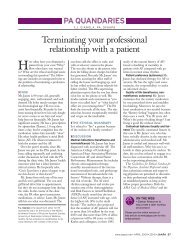Essential Guide to E-mail Marketing - Haymarket
Essential Guide to E-mail Marketing - Haymarket
Essential Guide to E-mail Marketing - Haymarket
You also want an ePaper? Increase the reach of your titles
YUMPU automatically turns print PDFs into web optimized ePapers that Google loves.
32 INFRASTRUCTURE DM News • E-Mail <strong>Marketing</strong> <strong>Guide</strong> 2007<br />
Spam finally has a definition<br />
BY JORDAN COHEN<br />
When industry groups first started tackling deliverability best<br />
practices a few years ago, the struggle <strong>to</strong> define spam raised<br />
some controversial questions. Marketers, ISPs, consumer groups<br />
and government agencies alike wondered: Should all unsolicited<br />
commercial e-<strong>mail</strong> be considered spam? Or just unsolicited bulk<br />
commercial e-<strong>mail</strong>? Or perhaps it’s any e-<strong>mail</strong> sent without permission;<br />
bulk, commercial or otherwise?<br />
Eventually, attempts <strong>to</strong> define spam were abandoned, as no one<br />
could agree on a meaning that would encompass all unwanted<br />
messages while excluding legitimate e-<strong>mail</strong>. Besides, a definition<br />
seemed irrelevant when an estimated one-in-five commercial<br />
e-<strong>mail</strong>s were getting caught in filters for failing content checks or<br />
poor bounce management, even when specifically requested by<br />
the consumer.<br />
Fast forward <strong>to</strong> 2007, and we may finally have a definition for<br />
spam. Yahoo’s <strong>to</strong>p e-<strong>mail</strong> operations executive, Miles Libbey, senior<br />
product manager at Yahoo Mail, probably put it best at the<br />
Federal Trade Commission’s recent Spam Summit: “Operationally,<br />
we define spam as anything users don’t want in their inbox,”<br />
Libbey said. It’s short, sweet, highly understandable and 100 percent<br />
consumer-centric. But it’s also a definition that may frighten<br />
the many marketers who previously believed that acquiring affirmative<br />
consent meant they would never be considered spammers.<br />
As we move closer <strong>to</strong> a time when consumer spam complaints<br />
will weigh heaviest on a marketers’ deliverability and ROI, successful<br />
firms will increase their focus on making sure that every<br />
e-<strong>mail</strong> they send is relevant, valuable, welcomed and wanted by its<br />
recipients. To survive and thrive in the next phase of e-<strong>mail</strong> marketing,<br />
keep these two core principles in mind:<br />
■ How you give notice trumps how you get permission. Getting<br />
consumers’ permission is meaningless unless you are clear about<br />
what they are agreeing <strong>to</strong> when they sign up. At a recent industry<br />
conference, AOL’s postmaster, Charles Stiles, <strong>to</strong>ld attendees, “I<br />
don’t care if they triple opted-in and gave you their credit card<br />
number.” He drew chuckles, but made his point loud and clear:<br />
Opt-in is meaningless if consumers subsequently click the “Report<br />
Spam” but<strong>to</strong>n.<br />
■ Relevancy rules. There are no<br />
“throw away” communications in<br />
the e-<strong>mail</strong> world, where consumers<br />
provide immediate and<br />
constant feedback about what<br />
they think of your programs <strong>to</strong><br />
their ISPs. Before clicking send,<br />
always ask yourself, “Is the individual<br />
recipient I’m sending this<br />
<strong>to</strong> going <strong>to</strong> find it valuable?” And<br />
while you’re at it, “Would I be<br />
Jordan Cohen<br />
happy <strong>to</strong> receive this message.”<br />
Epsilon<br />
Jordan Cohen is direc<strong>to</strong>r of industry and government relations at Epsilon. He<br />
can be reached at jcohen@epsilon.com.<br />
ESSENTIAL GUIDE<br />
Controlling messaging costs<br />
BY BARRY ABEL<br />
For every message that doesn’t make it <strong>to</strong> the intended inbox,<br />
the bot<strong>to</strong>m line takes a direct hit. The number one reason why<br />
<strong>mail</strong> doesn’t get delivered is infrastructure. Infrastructure in the<br />
e-<strong>mail</strong> world means MTA (Message Transfer Agent) and is the<br />
way your company presents itself <strong>to</strong> the ISP community. But most<br />
companies’ sending infrastructures are not conducive <strong>to</strong> handling<br />
large volumes of outbound <strong>mail</strong>. Common sending architecture<br />
falls in<strong>to</strong> two camps. The first is composed of open source solutions<br />
such as Send<strong>mail</strong>, which<br />
requires dozens of servers <strong>to</strong> meet<br />
volume and speed requirements.<br />
The second includes early-<strong>to</strong>-market<br />
spam engines intended <strong>to</strong><br />
send high volumes of <strong>mail</strong>, but<br />
without the control features<br />
required <strong>to</strong> secure delivery and a<br />
positive reputation. Neither<br />
approach is optimal.<br />
There are, however, several<br />
ways companies can optimize<br />
Barry Abel<br />
their infrastructure <strong>to</strong> reduce<br />
Message Systems<br />
costs and improve deliverability.<br />
■ Improve infrastructure performance There is a tremendous<br />
cost <strong>to</strong> running servers, so if you can reduce the number you need<br />
<strong>to</strong> support, you au<strong>to</strong>matically reduce costs. Adopting a solution<br />
that will allow each server <strong>to</strong> send millions of messages per hour<br />
with ability <strong>to</strong> maintain 100k concurrent connections, results in a<br />
10:1 hardware reduction.<br />
■ Insist on virtual IP support By adopting an infrastructure that<br />
supports virtual IPs — the ability <strong>to</strong> segment traffic by unlimited<br />
IP addresses on a server — you can optimize your throughput for<br />
each type of <strong>mail</strong> you send <strong>to</strong> each ISP.<br />
■ Cluster servers This will allow you <strong>to</strong> configure, manage and<br />
support all servers from a single interface.<br />
■ Establish bounce classifications and a list hygiene process This<br />
will decrease <strong>mail</strong>ing costs, because you’ve eliminated bad addresses<br />
by setting up an au<strong>to</strong>mated way <strong>to</strong> handle bounced <strong>mail</strong>.<br />
■ Obtain workflow and policy management capability Being able<br />
<strong>to</strong> set <strong>mail</strong> processing policies in advance saves admin time and<br />
processing power. Setting thresholds <strong>to</strong> alert admin of deliverability<br />
problems will help catch problems early so they can be corrected.<br />
■ Prepare for authentication To prevent messages from being<br />
blocked by ISPs using authentication technology, establish a policy<br />
<strong>to</strong> mark e-<strong>mail</strong> with DKIM and Sender ID.<br />
■ Adopt e-<strong>mail</strong> moni<strong>to</strong>ring E-<strong>mail</strong> moni<strong>to</strong>ring lets you know if<br />
your message landed in the inbox, a junk folder or was blocked<br />
by a spam catcher. Knowing this can give you a better chance of<br />
making changes that will get you <strong>to</strong> more inboxes.<br />
■ Insist on real-time reporting With real-time analytics, adjustments<br />
can be made before sending subsequent campaigns.<br />
Barry Abel is vice president of field operations at Message Systems. He can be<br />
reached at barry.abel@messagesystems.com.
















